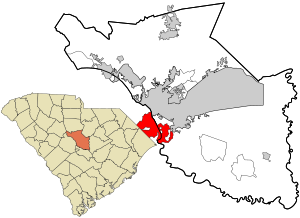Cayce, South Carolina
| Cayce, South Carolina | |
|---|---|
| City | |
| Motto: "A new kind of city" | |
 Location in Richland County and the state of South Carolina. |
|
| Coordinates: 33°57′48″N 81°4′0″W / 33.96333°N 81.06667°WCoordinates: 33°57′48″N 81°4′0″W / 33.96333°N 81.06667°W | |
| Country | United States |
| State | South Carolina |
| County | Lexington and Richland |
| Government | |
| • Mayor | Elise Parton |
| Area | |
| • Total | 17.4 sq mi (45.1 km2) |
| • Land | 16.6 sq mi (43.1 km2) |
| • Water | 0.8 sq mi (2.0 km2) |
| Elevation | 240 ft (73 m) |
| Population (2010) | |
| • Total | 12,528 |
| • Density | 720/sq mi (280/km2) |
| Time zone | Eastern (EST) (UTC-5) |
| • Summer (DST) | EDT (UTC-4) |
| ZIP code | 29033 |
| Area code(s) | 803 |
| FIPS code | 45-12655 |
| GNIS feature ID | 1247197 |
| Website | www |
Cayce is a city in Lexington and Richland counties in the U.S. state of South Carolina, along the Congaree River. The population was 12,528 at the 2010 census. It is part of the Columbia, South Carolina, Metropolitan Statistical Area.
Cayce lies mostly across the Congaree River from the state capital of Columbia, with a newly annexed section on the Richland County side awaiting development. Because both it and the neighboring city of West Columbia share road names and schools, they are sometimes referred to jointly as "Cayce-West Columbia". However, they are politically separate cities.
The Congaree River has always played a dominant role in Cayce's development. Cayce and other local governments jointly developed the Riverwalk along the Congaree, which provides walking, jogging, and nature observation opportunities. Development on both sides of the river is an important factor driving the city's economy.
What was to become Cayce was home to Native Americans have for at least 12,000 years; This includes what is now known as the Manning Archeological Site, the SAM Site, and the Taylor Site.
Hernando de Soto reached the area in 1540, encountering a large Indian village at Congaree Creek, where Cayce now stands. Near the end of the 17th century, explorers such as John Lawson visited and documented his trip.In 1718, the English built the first permanent fort, becoming the first structure built in the Midlands. A second fort was built on the river in 1748. These forts were referred to as Congaree Fort #1 and Congaree Fort #2, and became part of the Congarees Site in 1974.
...
Wikipedia
